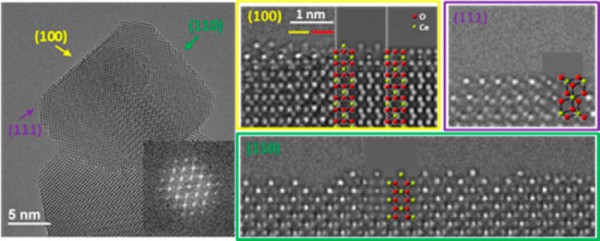One Nanocrystal, Many Faces: Connecting the Atomic Surface Structures of Cerium Dioxide Nanocrystals to Catalysis

Image courtesy of Northwestern University The image on the left shows the general shape of a cubic cerium dioxide nanoparticle. The images on the right show edge-on views of three exposed surfaces at atomic resolution. The atomic models are overlaid on the simulated images to illustrate atom positions.
When it comes to reducing the toxins released by burning gasoline, coal, or other such fuels, the catalyst needs to be reliable. Yet, a promising catalyst, cerium dioxide (CeO2), seemed erratic. The catalyst’s three different surfaces behaved differently.
For the first time, researchers got an atomically resolved view of the three structures, including the placement of previously difficult-to-visualize oxygen atoms. This information may provide insights into why the surfaces have distinct catalytic properties.
The Impact
Solving the three different atomic surface structures of CeO2 nanoparticles provides insight into how to potentially control the morphology of the nanoparticles to improve catalytic selectivity, activity and stability. This knowledge provides an opportunity to potentially improve the catalytic properties of CeO2 nanoparticles in catalytic converters in vehicles and other applications.
Summary
Cerium oxide (CeO2) nanoparticles are widely used in chemical catalysis. Typical CeO2 catalytic nanoparticles have three main surfaces exposed: (100), (110) and (111). Previous studies show that the differing catalytic properties of each surface are closely related to the atomic structure of the surface. Unfortunately, scientists had difficulties in visualizing the oxygen atoms that pack these surfaces.
The challenge was overcome by a team of researchers at Northwestern University, Oak Ridge National Laboratory, and Argonne National Laboratory. The researchers determined the surface structures using the most advanced chromatic and spherical aberration-corrected electron microscope at Argonne National Laboratory. The microscope enables clear imaging of both cerium and oxygen atoms.
For the high energy (100) surface, the presence of cerium, oxygen, and reduced cerium oxide terminations on the outermost surface as well as the partially occupied lattice sites in the near-surface region (~1 nm from the surface) were directly observed. The disordered surface demonstrates that the previous understanding of the (100) surface was oversimplified.
For the (110) surface, a combination of reduced flat CeO2-x surface layers and “sawtooth-like” (111) nanofacets exist. The (111) surface is terminated by an oxygen layer, precisely as anticipated from previous models, and consistent with its high stability.
Further, the surface structures derived from the microscopy study are consistent with results from a macroscopic infrared spectroscopy investigation. The variation in surface defect density between these three facets appears to be responsible for their differences in catalytic activity and potentially opens options to modify faces of CeO2 nanoparticles to develop face selective catalysts.
Funding
DOE Office of Science, Office of Basic Energy Sciences, Division of Chemical Sciences, Geosciences, and Biosciences.
Publications
Y. Lin, Z. Wu, J. Wen, K. R. Poeppelmeier, L. D. Marks, “Imaging the atomic surface structures of CeO2 nanoparticles.” Nano Letters 14, 191 (2014). [DOI: 10.1021/nl403713b]
Z. Wu, M. Li, D. R. Mullins, S. H. Overbury, “Probing the surface sites of CeO2 nanocrystals with well-defined surface planes via methanol adsorption and desorption.” ACS Catalysis 2, 2224 (2012). [DOI: 10.1021/cs300467p]
Contact Information
Kristin Manke
kristin.manke@science.doe.gov
Media Contact
All latest news from the category: Materials Sciences
Materials management deals with the research, development, manufacturing and processing of raw and industrial materials. Key aspects here are biological and medical issues, which play an increasingly important role in this field.
innovations-report offers in-depth articles related to the development and application of materials and the structure and properties of new materials.
Newest articles

An Endless Loop: How Some Bacteria Evolve Along With the Seasons
The longest natural metagenome time series ever collected, with microbes, reveals a startling evolutionary pattern on repeat. A Microbial “Groundhog Year” in Lake Mendota Like Bill Murray in the movie…

Witness Groundbreaking Research on Achilles Tendon Recovery
Achilles tendon injuries are common but challenging to monitor during recovery due to the limitations of current imaging techniques. Researchers, led by Associate Professor Zeng Nan from the International Graduate…

Why Prevention Is Better Than Cure—A Novel Approach to Infectious Disease Outbreaks
Researchers have come up with a new way to identify more infectious variants of viruses or bacteria that start spreading in humans – including those causing flu, COVID, whooping cough…



